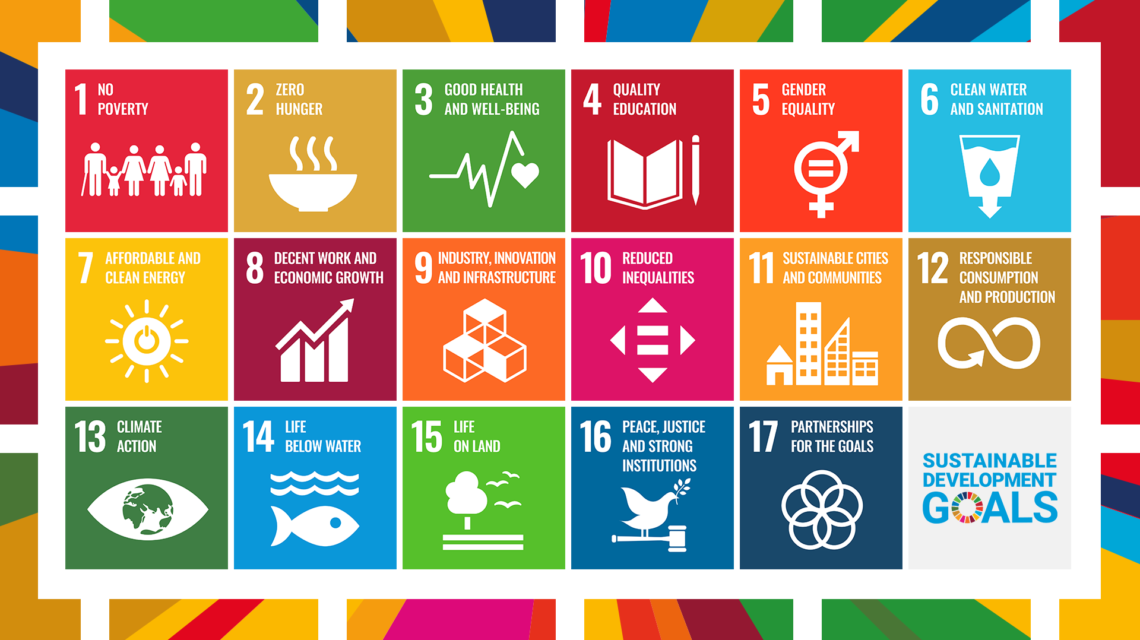The 17 Sustainable Development Goals
The 17 Sustainable Development Goals (SDGs) of the United Nations are widely known nowadays. They have a huge relevance when it comes to global partnerships and cooperation in combating climate change, global poverty and inequalities. The 17 goals as well as their targets were defined by the General Assembly of the United Nations in 2015 and they form part of important agreements such as The Paris Agreement (2015).
The SDGs involve an agenda for a future worth living and a long-term wealthy life for everyone on earth.
Each of the 17 goals treats a different topic with subgoals and targets. Those targets then eventually lead to different specific actions.
Why are the SDGs relevant for companies, especially SMEs?
To whom are the goals addressed and what do they mean for a company’s activities and behaviours? A global goal like "No Poverty" might not seem influenceable or tangible for a small company. The responsibility is not limited to politicians when it is about reaching the goals though. Enterprises, especially small and medium-sized enterprises (SMEs), play an important role in the implementation of the SDGs because they have direct influence on local people, society, environment and economy. In many countries, SMEs account for the majority of jobs and are key drivers for local innovation and economy.
Basically, the SDGs can help companies developing a vision on how to contribute to a sustainable development. They can also be used as a guideline for concrete measures against climate change, for example.
Many SMEs might already contribute to the SDGs without even knowing. For instance, a company that pays fair salaries regardless of the employee's gender is already targeting two goals:
- Goal 5: Gender Equality
- Goal 8: Decent Work and Economic Growth
How to integrate SDGs into corporate strategy?
How can we actively integrate the SDGs into our corporate strategy?
- Initially, it is necessary to determine which of the 17 goals are relevant to the company and its activities. A materiality analysis can be a valuable tool for this.
- Afterwards, the relevant goals are grouped according to their priorities. This can be done in different ways. For example, one can consider the possible damage as a sorting criterium. Higher possible damage and/or higher risk then would mean a higher priority. A fashion company, for instance, that produces its clothes in a low-income country, might keep a closer eye on SDG 1: "No Poverty" and on the local working conditions (SDG 8: "Decent Work and Economic Growth").
- With the help of the defined priorities, specific measures can be defined. Those are directly linked to the SDGs and build clear actions. The goals and measures should be frequently checked and adjusted. Appropriate instruments and management tools should be used here to manage progress and impacts properly.
Advantages for SMEs when working with Sustainable Development Goals
Why should companies integrate SDGs into corporate strategy and activities?
At first sight, there are a couple of obvious reasons. A company has a social and ecological responsibility towards environment and society, thus minimizing actual and potential damage should be an obligation. At the same time, corporations, their employees and environment benefit from promoting prosperity, contributing to the fight against poverty as well as to the right to self-determination and the protection of human rights. Unfortunately, those obvious reasons often do not offer enough motivation for companies to work with SDGs as strategy guidelines.
If an enterprise integrates SDGs in all its areas, it can lead to decreasing operational costs and eventually increasing profit. Why? If, for instance, raw material in production is used more efficiently, it can reduce material costs and at the same time contribute to the company’s climate strategy. Additionally, the revenues might grow as well because many customers prefer more sustainable products. This might lead to more trust and loyalty from customers. Integrating and working with SDGs can thus create a competitive advantage and eventually lead to new market opportunities.
By integrating SDGs into business, risks can be minimized. Companies that engage with becoming more sustainable with the help of SDGs should take a closer look at all processes in their value chain. As a result, critical compliance issues can be detected before becoming serious problems. Consequently, the cost of inaction – the potential cost of doing nothing – can be minimized or even avoided by working with the integration of SDGs.
Furthermore, many career starters nowadays lay value on employers with a sustainable business model and employee-friendly working atmosphere. A sustainable corporate strategy that relies on and contributes to the SDGs can build an additional purpose for employees. This eventually involves a better identification of the workers with the company which ultimately leads to less fluctuation and better performance.
The SDGs also play a key role in the preparation of sustainability reports because they can provide a clear overview of the areas and activities defined and operated by the company regarding climate protection, human and labour rights and governance.
Our team at Sustainable Disruption is happy to support you, whether its from scratch, conducting a materiality analysis or creating a sustainability report or sustainability strategy advising. With our consultation, you’ll get the best results.
